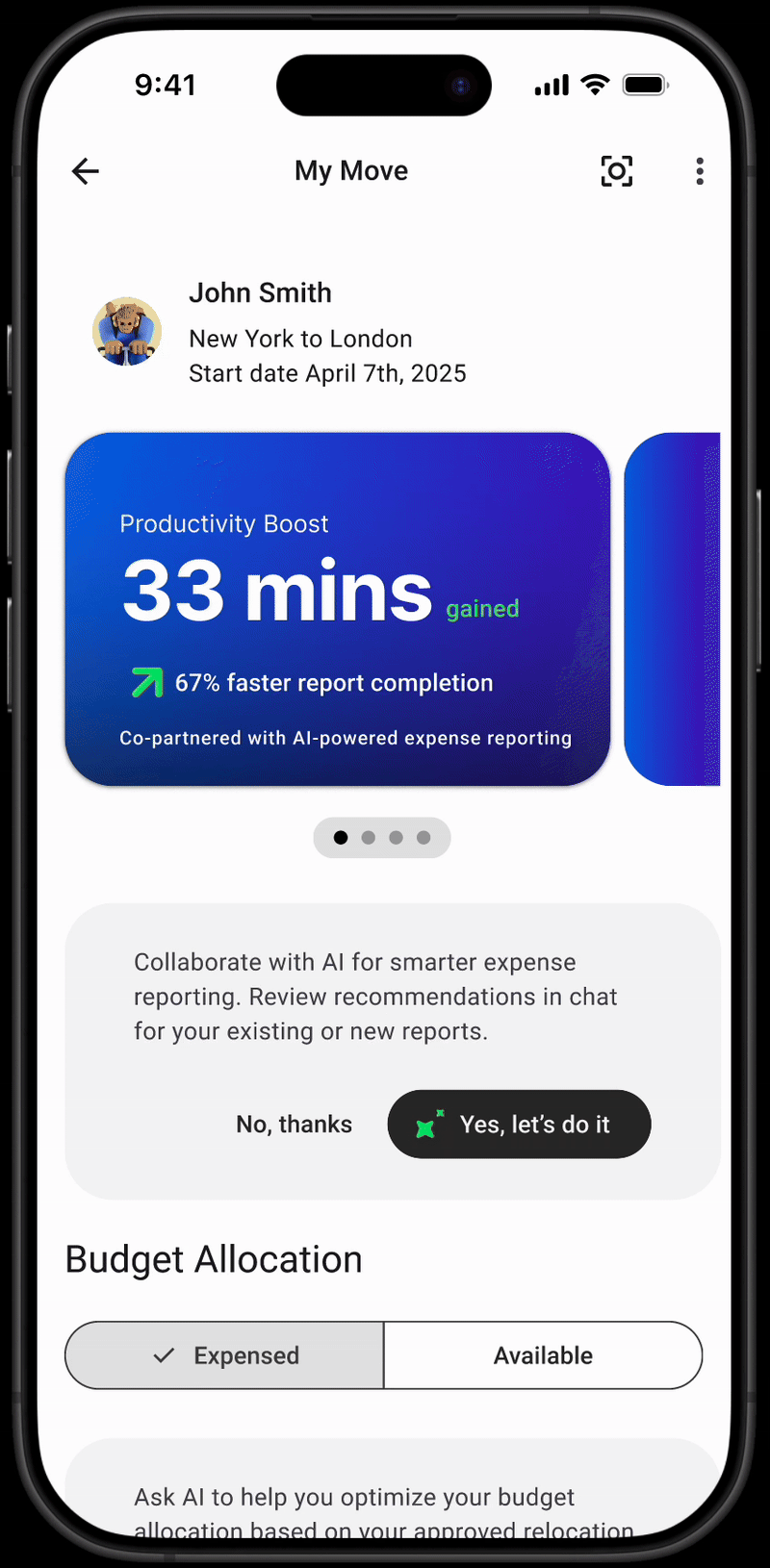Overview
Relocating for work is stressful—and expense reporting shouldn’t add to that. This project focused on improving productivity for employees relocating domestically or internationally due to talent opportunities, by simplifying how they capture and submit relocation-related expenses through.
My Role | Lead Product Designer
As the Product Designer, I led the user experience design for the end-to-end expense reporting workflow. This included;
-
understanding the current ecosystem of relocation management at Cartus.
-
Creating a service blueprint including customer actions, frontstage interactions, backstage processes, and support systems
-
Competitive analysis of the marketplace tools available for expense management.
-
Mapping the journey of relocating employees.
-
Creating intuitive UI patterns
-
Collaborating with cross-functional teams to ensure technical feasibility, data availability and business alignment.
Design | Opportunity
A fast, frictionless self-serve expense reporting for relocating talent transitioning to their new role.
Dashboard View
The UI combines familiar elements with innovative AI features to ensure a seamless user experience –
Conversational chatbot – multimodal AI, with a clear overview of the increase in productivity of the user and their expense status and history.


Background
Industry - Real Estate & Mobility
Cartus, a global Relocation Management Company (RMC), manages employee relocations for 2,000+ companies, including Fortune 100/500 and mid-size businesses across 190 countries.
Challenge | Navigate a Fragmented Landscape of Expense Reporting
Whether moving domestically or internationally, the relocating employees were overwhelmed by receipts, understanding in-policy rules for benefits & services, and submission timelines. Many dropped off before completing reports, or submitted incomplete data—delaying reimbursement and creating administrative overhead. Our goal was to reduce cognitive effort and streamline the reporting process from start to finish.
Impact
This fragmented approach creates bottlenecks, increases operational costs, and diminishes user satisfaction. A seamless AI-powered system can unify and streamline the experience for both employees and Cartus.
Value Proposition
A fast, intuitive expense reporting experience for employees relocating due to a new role or promotion—reducing friction, improving accuracy, and supporting productivity during a high-impact career transition.
Current view
Messages & tasks
Low adoption with manual expense reporting. Policy benefits & sevices can be reviewed in FAQ and exceptions handling are resolved with Consultants set up for the case handling.


Future view
1. Dashboard - NLP & NLU, context awareness
A personalized relocation expense dashboard showing spending insights, budget allocation, and AI-powered recommendations in chat.

AI Usage
-
Context Awareness (NLU) - Recognizes the user's move details and spending patterns.
-
AI Recommendations - Uses predictive analytics to suggest budget optimizations.
2. Chat - Upload Receipt
A chatbot guiding the user to upload or capture a receipt for expense tracking.

AI Usage
-
Conversational AI (NLU + Context Awareness)
Understands user intent and guides them interactively.Context-aware prompts addressing user curiosity & learning.

Business Goals
-
Accelerate Expense Submission - Reduce the time relocating employees spend on submitting expenses by automating key processes.
-
Enhance Reimbursement Speed - Cut down processing time through real-time policy checks and automated approvals.
-
Lower Operational Overhead - Decrease the volume of expense-related inquiries and manual reviews by Cartus account managers, ensuring smoother interactions and improved client satisfaction.
Discover the current ecosystem with the fragmented experiences

EVENT - Siloed System |
IMPACT - Disjointed information flow

EVENT - High Error Rates |
IMPACT - Customer dissatisfaction

EVENT - Process Delays |
IMPACT - Lowered consumer trust

EVENT - Increased Workload for Cartus Consultants |
IMPACT - Demotivation, burnout
Expense submission, validation, and reimbursement occur across multiple disconnected platforms, leading to inefficiencies.
Manual entries and policy misalignment cause frequent inaccuracies, increasing the need for corrections and resubmissions.
Lack of automation slows down approvals, making reimbursements unpredictable and frustrating.
Manual alignment of expense records with complex client policies, heightening administrative burdens and the risk of discrepancies.

Discover | Fragmented Experience
Fragmented relocation experience with disconnected systems, manual processes, and platform switching—leading to inefficiencies, errors, and delays.

Define | Connected Ecosystem
A connected ecosystem powered by AI, data insights, and seamless collaboration—boosting efficiency, accuracy, and financial control.
Define a future state of a connected ecosystem

Converge to follow through one journey - Customer experience
Problem Statement
We empathize and think of the overwhelming challenges faced by relocating employees - starting a new life, in a new place, a new job, new colleagues, and supporting their family's settling into a new culture.
-
Relocating employees face challenges in managing expenses across different stages of their move.
-
Current manual reporting systems are slow, error-prone, and inefficient.
-
Cartus account managers struggle with processing delays, miscommunications, and administrative overhead.
The relocating employees OR the individuals who are the customer, interact with several individuals during their move;
Client - the company hiring/moving the talent
Internal employee - Cartus (relocation management),
Real estate agents & brokerages - Global market
Suppliers - Domestic/International - bookings & move management
Service providers - media subscriptions, immigration, banking & taxation, insurance etc.
Hypothesis
By leveraging intelligent automation and conversational interfaces, we can streamline expense reporting for faster & timely reimbursements. This will reduce administrative burden, and improve the relocating employee experience.
Solution | Personalized experience
Seamless connection with no platform & context switching and intelligent informed context-aware support to customers.


Conversational AI | Context-aware chatbot for a personalized customer experience
Receipt Capture - Computer Vision
The app scans and highlights a receipt for OCR extraction.
Edge Detection & Image Processing: Identifies and frames the receipt for accurate scanning.
Receipt Details - AI Categorization & Policy Mapping
The extracted receipt data is presented with AI-suggested linking to policy for the benefits & services authorized for the relocation.

AI Usage
-
Computer Vision (OCR) - Extracts text from the receipt image.
-
Edge Detection & Image Processing - Identifies and frames the receipt for accurate scanning.

Ready to expense
Context Awareness
The chatbot suggests context-aware prompts for easy expense assignment and quick access to linked Company Policy.
Expense Report Selection - Context Awareness
User selects which report to assign the expense to, with an option to create a new report.


AI Usage - in both frames,
-
Context Awareness (NLU) - Identifies active reports and suggests relevant options.
-
Dynamic UI Adaptation - Updates available actions based on user choices.
AI Usage
-
OCR & NLP - Extracts details from the receipt.
-
Entity Recognition & Policy Mapping - Links expenses to categories based on company policy using NLP.
-
Confidence Score - Indicates AI certainty in data extraction accuracy.

Edge case handling | Overage scenario
Expense Limit Notification - Retrieval-Augmented Generation (RAG)
Chatbot alerts the user of exceeded limit, offering actions with context-aware prompts.

Expense Adjustment & Confirmation - RAG for AI-driven Policy Adherence
Conversational AI interprets and responds to policy-based constraints.

AI Usage - in both frames,
-
Dynamic Data Retrieval – The system pulls real-time expense information from linked policy data, showing the user the adjusted amount.
-
Automated Policy compliance - AI adjusts the amount to ensure adherence.
-
Context Awareness prompts
Design Hypotheses | Customer Experience
-
User Behavior Hypothesis - We believe that providing a real-time, conversational expense submission experience will reduce the reporting time by 50%, as users will benefit from immediate policy validation and automated data entry.
-
Interface Integration Hypothesis - We hypothesize that integrating voice commands and mobile receipt scanning into a unified chatbot interface will drive higher user adoption and satisfaction compared to traditional manual systems.
-
Value Hypothesis - We expect that automated expense validation and proactive notifications will lead to a 30% reduction in support queries, directly correlating to enhanced operational efficiency and improved user experience.
Insight gathering | User goals, pain points & touchpoints in the ecosystem
Scope of Focus - Process Mapping of the Manual Current State
Service Design - Taking a holistic approach, encompassing the entire service ecosystem, including frontstage (customer-facing processes) and backstage (internal operations). We focused on optimizing interactions across all touchpoints, both digital and non-digital, to understand the manual process of service delivery - that is, a successful move that relocates the employee to be ready on the desired start date of their job.
Purpose - to identify manual areas that will benefit from being connected with emerging technology.
Internal Employee & Client workflow to set up an employee for relocation
1. Work Flow - Cartus Employee manual input of Transferee move details
2. Process Map - Multiple roles that the Customer interacts with during their relocation

Process Mapping - Current State | Pain points, gaps in reaching goals and 'jobs to be done'
Ecosystem mapping revealed the users most affected & their primary needs - with a focus on Customer experience
Cartus Consultant/ Account Payables
Internal Employee
Reduced manual review workload, automated policy validation, and streamlined exception handling.
Relocating Employee/ Transferee
Customer
Easy, quick, and accurate expense management and submission with real-time eligibility checks. Currency conversion & support with policy adherence.
Client HR & Mobility Teams
Client
Policy enforcement, relocation budgeting insights, and smooth employee experience.
Product & Servise Vendors
Supplier
Easy, quick, and accurate invoice payments. Accurate household goods assessment. Easy scheduling & appointments with customer.

Customer process flow - Current State | Pain points and JTBD 'Jobs to be done'


Customer Experience - Market Research & User Insights
Expense management is a pain point impacting all experiences. As the move is initiated for the customer, we proceeded to address this need first.
Market Research & User Insights
-
72% of finance teams report manual expense tracking as their biggest productivity drain.
-
Employees spend an average of 4 hours per month manually submitting expenses.
-
Missed receipts or incomplete documentation account for 30% of reimbursement delays.
User feedback highlights frustration with fragmented tools that require switching between platforms for submission, approval, and reporting.

Solution | AI Application Strategy
The solution employs a multimodal AI - conversational chatbot integrated with mobile receipt scanning and voice recognition features. Key components include;
-
Automated Receipt Processing - Would use OCR to extract and auto-populate expense details from receipt images.
-
Real-Time Policy Validation - Instantly cross-checking each submitted expense against company policies, with dynamic feedback on eligibility and exception management.
-
Smart Expense Categorization - Leverage RAG to redirect the LLM to retrieve relevant information from data on Client policy to auto-suggest expense categories and prompt users for missing receipts when related claims are detected.
-
Multimodal Interaction - Will offer both text-based and voice-driven inputs to cater to diverse user preferences and on-the-go scenarios.
Data Requirements
To deliver personalized and accurate assistance, the system will need to collect and analyze,
-
Receipt and Expense Data - Images, amounts, dates, merchant details, and categories.
-
Company Policy Information - Detailed reimbursement guidelines and exceptions per employment level.
-
User Profiles & Historical Data - Past expense submissions to train auto-categorization and anomaly detection models.
-
Interaction Logs - User feedback and activity data to continuously refine AI accuracy and usability.
Technologies leveraged
AI/ML | LLM for NLP & NLU (Natural Language Process & Understanding) and RAG in conversational chatbots, computer vision for OCR text extraction, and multimodal AI integration for greater context-aware system.
Success Metrics
In deploying this solution, several challenges must be addressed,
-
Expense Submission Efficiency - Achieve a 50% reduction in the time required for expense submissions compared to manual processes.
-
Faster Reimbursement Turnaround - Reduce overall processing and reimbursement time by 40% through automated validations.
-
Reduced Support Queries - Lower expense-related inquiries by 30%, indicating clearer communication and fewer errors.
-
User Satisfaction -
-
Attain high user satisfaction scores (targeting >60% CSAT) from both relocating employees and Cartus account managers.
-
Set a benchmark for NPS Score - aiming initial score of 30+, considering below implementation challenges.
Implementation Challenges
In deploying this solution, several challenges must be addressed,
-
OCR & Speech Recognition Accuracy - Ensuring robust performance even with poor image quality or background noise.
-
Policy Complexity & Data Integration - Managing diverse and dynamic company policies while seamlessly integrating with existing financial systems.
-
Security & Privacy - Safeguarding sensitive financial data and user information against breaches.
-
User Adoption - Overcoming resistance to new technology, particularly among users less comfortable with AI-driven, voice-based interfaces.
Next Steps
Will work alongside UXR for a continuous discovery of the improvement in journeys.
-
Usability Test - Quantitative & Qualitative assessment to manage the success metrics.
-
Create a Playbook for improving Design principles consensus to drive adoption & increase retention.
Anywhere Real Estate

